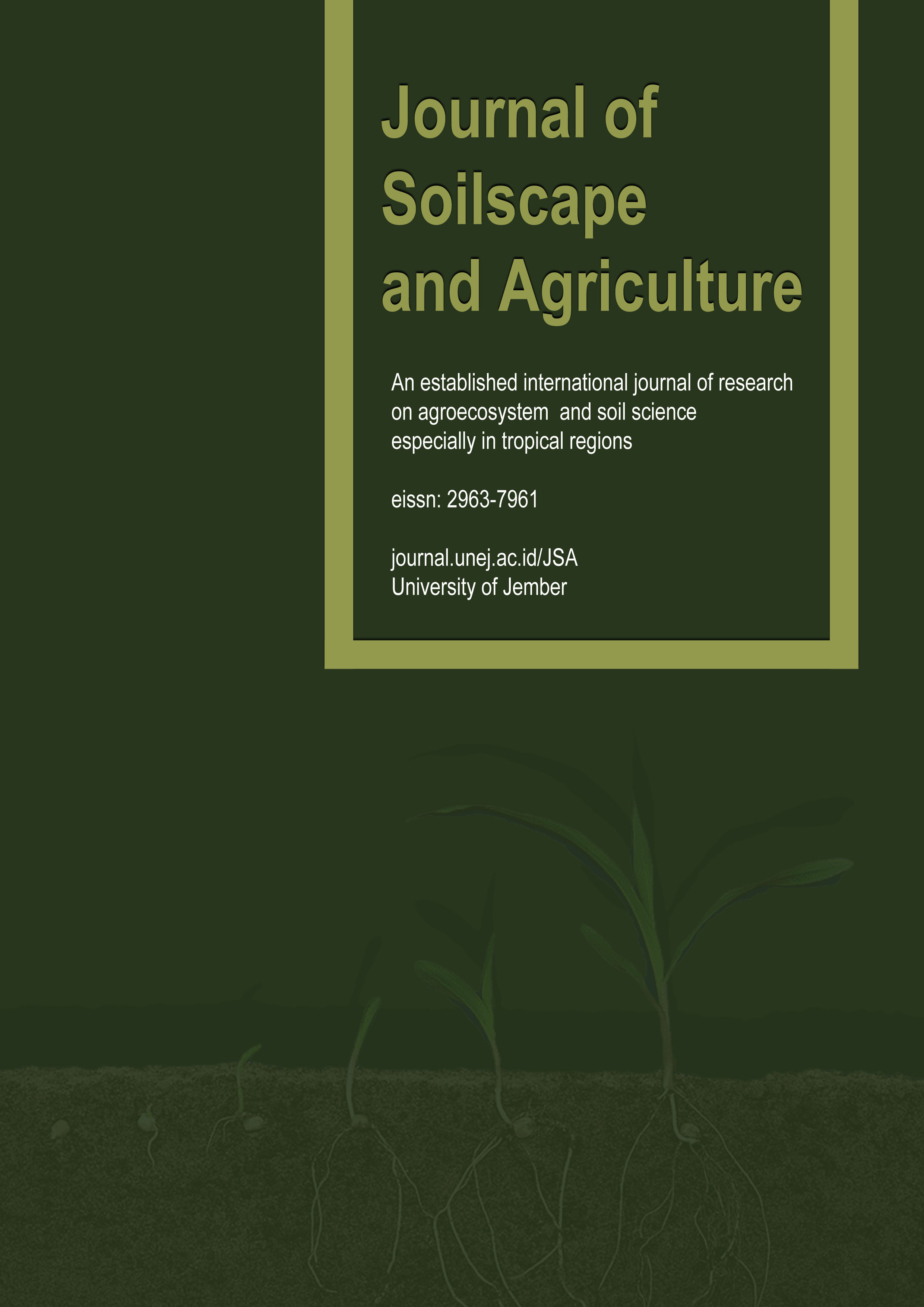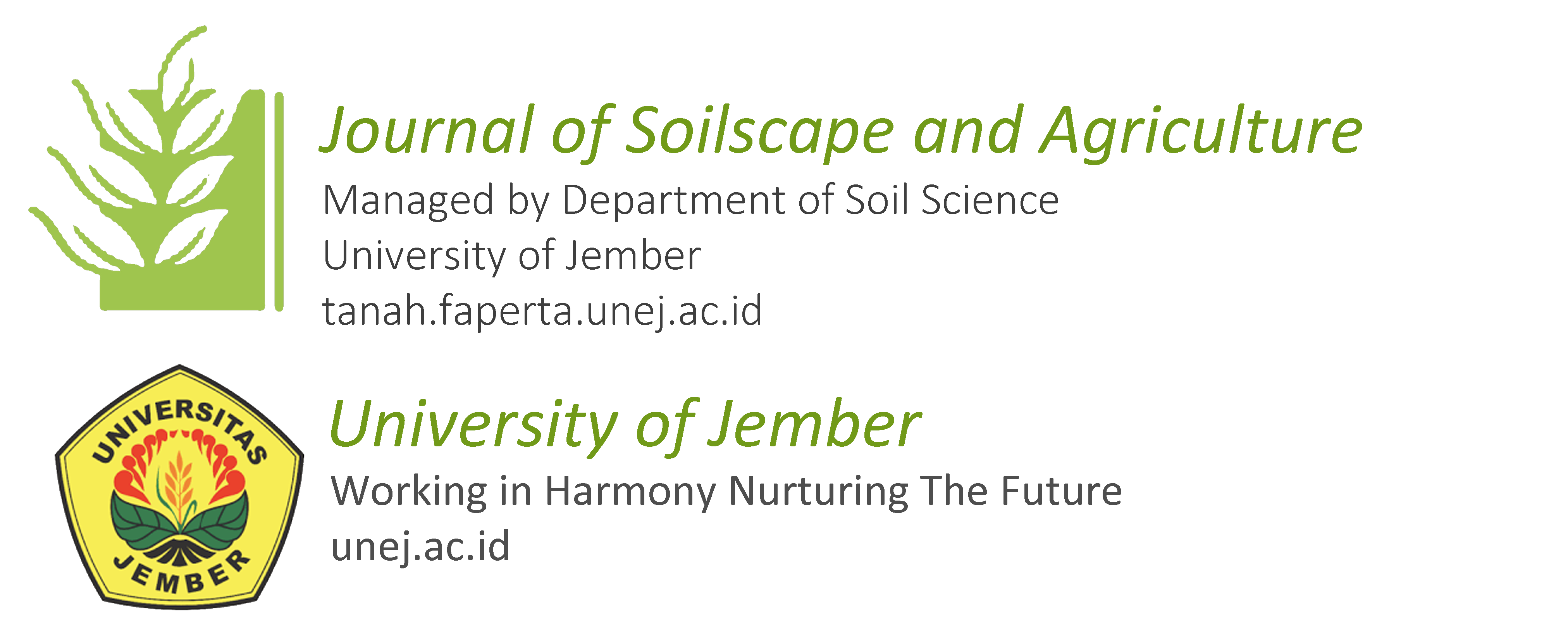Analysis of Erosion Hazard Index In Konaweha Sub-Watershed In Laosu Village, Bondoala Sub-District, Konawe District
DOI:
https://doi.org/10.19184/jsa.v3i2.5734Keywords:
Erosion Hazard Index (EHI), soil erosion, Universal Soil Loss Equation (USLE), land use, rainfall erosivityAbstract
The Erosion Hazard Index (EHI) is the ratio between potential erosion rate and allowable erosion rate, influenced mainly by climate (rainfall) and soil factors such as slope, slope length, land use, conservation practices, and soil physical-chemical properties. This study aims to determine the EHI in the Konaweha Sub Watershed, Laosu Village, Bondoala District, Konawe Regency, using the Universal Soil Loss Equation (USLE): A = R·K·L·S·C·P, compared to allowable erosion (ETol). Analysis shows variation in EHI across different land units, classified into low, moderate, and high hazard levels. The lowest EHI (0.02) occurs in dry/former agricultural land (U-06), moderate EHI (1.43) in swamp areas (U-04), and the highest EHI (6.71) in settlements (U-02). These differences arise due to varying potential erosion and tolerance levels, with major erosion drivers being rainfall erosivity, soil erodibility, slope steepness, and slope length. In general, residential lands (U-02 and U-03) have high erosion hazards (EHI 6.15–6.71), while dry/waste agricultural lands (U-08) and swamps (U-04) fall under moderate hazard. Other land uses such as mixed gardens (U-05) and built-up lands (U-01) show low erosion hazards (EHI <1.0). To mitigate erosion risks, the study recommends conservation practices such as contour planting and maintaining vegetation cover, especially in high-risk areas, to ensure sustainable land use and reduce soil degradation.
References
Alewell, C., Egli, M., & Meusburger, K. (2015). An attempt to estimate tolerable soil erosion rates by matching soil formation with denudation in Alpine grasslands. Journal of Soils and Sediments, 15(6), 1383–1399. https://doi.org/10.1007/S11368-014-0920-6
Alwi L. 2012. Kajian dampak dinamika penggunaan lahan di DAS Wanggu terhadap sedimentasi di Teluk Kendari [Disertasi]. Sekolah Pascasarjana Institut Pertanian Bogor.
Arsyad, S. 2000. Soil and Water Conservation. IPB Press. Bogor
Arsyad, S. 2006. Soil and Water Conservation. IPB. Press. Bogor
Asdak, C. 2010. Soil and Water Conservation. Second Printing IPB. Press. Bogor Asdak, C., 2002. Hydrology and Management Watershed. Gajah Mada University Press. Yogyakarta.
BPDAS Sampara. 2009. Konaweha Watershed Integrated Management Plan. Sampara Watershed Management Center of Southeast Sulawesi Province. Kendari, Southeast Sulawesi.
Chornyy, S., & Poliashenko, N. (2017). Determination of Soil-loss Tolerance for Chernozem of Right-Bank Ukraine (pp. 109–119). Springer, Cham. https://doi.org/10.1007/978-3-319-45417-7_9
Duan, X., Xie, Y., Liu, B., Liu, G., Feng, Y., & Gao, X. (2012). Soil loss tolerance in the black soil region of Northeast China. Journal of Geographical Sciences, 22(4), 737–751. https://doi.org/10.1007/S11442-012-0959-5
Erol, A., Koşkan, Ö., & Başaran, M. A. (2015). Socioeconomic modifications of the universal soil loss equation. Solid Earth, 6(3), 1025–1035. https://doi.org/10.5194/SE-6-1025-2015
Karkee, M., McNaull, R. P., Birrell, S. J., & Steward, B. L. (2012). Estimation of optimal biomass removal rate based on tolerable soil erosion for single-pass crop grain and biomass harvesting system. Transactions of the ASABE, 55(1), 107–115. https://doi.org/10.13031/2013.41259
Karkee, M., McNaull, R. P., Birrell, S. J., & Steward, B. L. (2012). Estimation of optimal biomass removal rate based on tolerable soil erosion for single-pass crop grain and biomass harvesting system. Transactions of the ASABE, 55(1), 107–115. https://doi.org/10.13031/2013.41259
Lisetsky, F. N., Голеусов, П. В., & Buryak, Z. (2024). Tolerable soils erosion losses and soil formation rates in the context of carbon balance regulation. Vestnik Moskovskogo Universiteta. Seriâ 17, Počvovedenie, 79(№3, 2024), 139–151. https://doi.org/10.55959/msu0137-0944-17-2024-79-3-139-151
Mey, D. 2003. Land Suitability for Cocoa Crops in the South North Baru District of Baru Regency, Maluku Province. Thesis of Graduate Program of MIPA Science, Geography Study Program. UGM. Yogyakarta.
Milekić, A. (2024). Calculation of the crop and crop menagment factor for assasment of potential erosion using usle model – case study Derenovac site, Paraćin. Leskovački Zbornik, 64(1), 21–32. https://doi.org/10.46793/lz-liv1.021m
Paimin., Sukresno., Purwanto. 2010. Sidik Cepat Degradasi SUB Daerah Aliran Sungai (SUB DAS). Pusat Penelitian dan Pengembangan Konservasi dan Rehabilitasi. Badan Penelitian dan Pengembangan Kehutanan. Bogor.
Prasuhn, V. (2022). Experience with the assessment of the USLE cover-management factor for arable land compared with long-term measured soil loss in the Swiss Plateau. Soil & Tillage Research, 215, 105199. https://doi.org/10.1016/J.STILL.2021.105199
Pretorius, J. R., & Cooks, J. (1989). Soil Loss Tolerance Limits: An Environmental Management Tool. GeoJournal, 19(1), 67–75. http://www.jstor.org/stable/41144493
Rahim, S.E. 2018. Pengendalian Erosi Tanah dalam Rangka Pelestarian Lingkungan Hidup. PT. Bumi Aksara. Jakarta.
Soniari, N. N., Trigunasih, N. M., Sumarniasih, M. S., & Saifulloh, M. (2024). Exploring soil erodibility: integrating field surveys, laboratory analysis, and geospatial techniques in sloping agricultural terrains. Journal of Degraded and Mining Lands Management, 12(1), 6533–6544. https://doi.org/10.15243/jdmlm.2024.121.6533
Sucipto. 2007. Analisis Erosi yang Terjadi di Lahan Karena Pengaruh Kepadatan Tanah. Wahana Teknik Sipil. Vol. 12:15-60 No. 10 Edisi April 2007.
Tesfaye, G., & Ameyu, T. (2021). Soil Erodibility Analysis and Mapping in Gilgel Gibe-I Catchment, Omo-Gibe River Basin, Ethiopia. https://doi.org/10.1155/2021/8985783
Tsai, F., Lai, J.-S., Nguyen, K. A., & Chen, W. W. (2021). Determining Cover Management Factor with Remote Sensing and Spatial Analysis for Improving Long-Term Soil Loss Estimation in Watersheds. ISPRS International Journal of Geo-Information, 10(1), 19. https://doi.org/10.3390/IJGI10010019
Xiong, M., Leng, G., & Tang, Q. (2023). Global Analysis of the Cover-Management Factor for Soil Erosion Modeling. Remote Sensing, 15(11), 2868. https://doi.org/10.3390/rs15112868
Downloads
Published
How to Cite
Issue
Section
License
Copyright (c) 2025 Journal of Soilscape and Agriculture

This work is licensed under a Creative Commons Attribution-NonCommercial-ShareAlike 4.0 International License.



